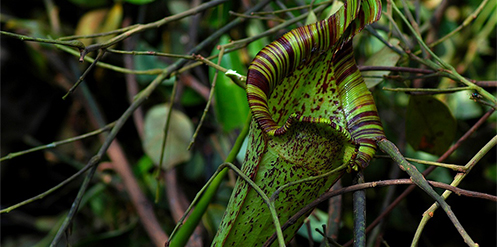April 03, 2018
Meet the Nepenthes rafflesiana, better known as the Raffles’ pitcher -plant, a species of tropical pitcher plant found in Brunei, Singapore, Malaysia and Indonesia.
Native to tropical lowlands, it especially wide distribution in Kalimantan, Sumatra, the Riau Archipelago, and the Malay Peninsula, including Johor.
The N.rafflesiana is the rarest out of three species of pitcher plants found in the Restorasi Ekosistem Riau (RER) area. However, its exact numbers in the RER area are unknown.

N.rafflesiana produces two types of pitchers – lower pitchers and upper pitchers – which are used to capture and kill insects for nutrients.
The carnivorous plant lures prey into its pitchers using sweet nectar secreted by its peristomes (the grooved area fringing the pitcher’s mouth).
Once an insect is inside the plant, it finds that it is unable to climb the slippery pitcher walls and drowns. The insect is then slowly digested by enzymes found in the pitcher’s liquid.
Due to its size, the N.rafflesiana is even capable of trapping small vertebrates, such as rats and lizards.
The pitcher plants are quite colourful, commonly containing purple, maroon, green or even white streaks, with thick stems measuring 1cm in diameter, and tendrils up to 110cm long. They are climbers, capable of climbing up to a height of 15m.
The N.rafflesiana generally occurs in open and sandy areas with high humidity, such as health forests, peat swamp forests, tropical forests and beach cliffs.
It grows on elevated areas – ranging from a few metres above sea level up to 1,200m and even 1,500m.
The N.rafflesiana is currently listed by the International Union for Conservation of Nature (IUCN) as a species of least concern (LC) with a low risk of extinction.
However, it is often traded as an exotic plant and is listed on Appendix II in CITES (Convention on the International Trade of Endangered Species), an international agreement between countries which governs the international trade of wild animal and plant species.
CITES II species are those that are not necessarily threatened with extinction but may become so unless trade of the species is closely controlled.
The N.Rafflesiana is one of the 152 species of plants included in a biodiversity of Kampar Peninsula Report which was published by the RER in 2016.